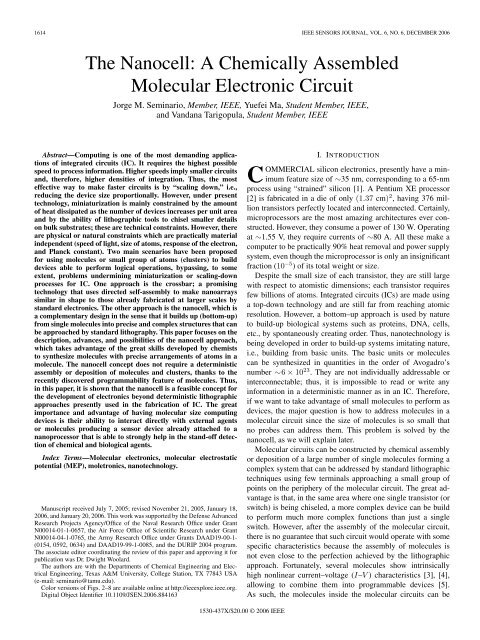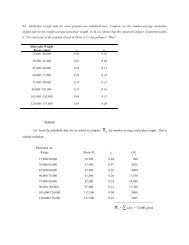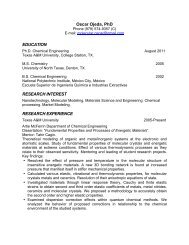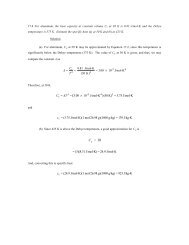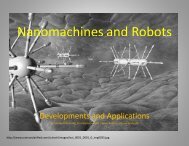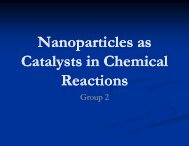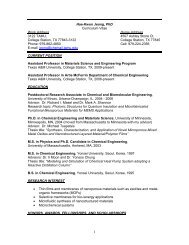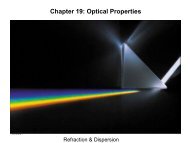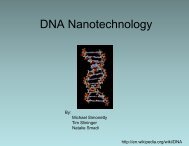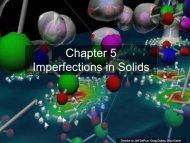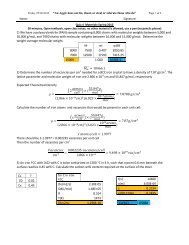The Nanocell: A Chemically Assembled Molecular ... - IEEE Xplore
The Nanocell: A Chemically Assembled Molecular ... - IEEE Xplore
The Nanocell: A Chemically Assembled Molecular ... - IEEE Xplore
Create successful ePaper yourself
Turn your PDF publications into a flip-book with our unique Google optimized e-Paper software.
1614 <strong>IEEE</strong> SENSORS JOURNAL, VOL. 6, NO. 6, DECEMBER 2006<strong>The</strong> <strong>Nanocell</strong>: A <strong>Chemically</strong> <strong>Assembled</strong><strong>Molecular</strong> Electronic CircuitJorge M. Seminario, Member, <strong>IEEE</strong>, Yuefei Ma, Student Member, <strong>IEEE</strong>,and Vandana Tarigopula, Student Member, <strong>IEEE</strong>Abstract—Computing is one of the most demanding applicationsof integrated circuits (IC). It requires the highest possiblespeed to process information. Higher speeds imply smaller circuitsand, therefore, higher densities of integration. Thus, the mosteffective way to make faster circuits is by “scaling down,” i.e.,reducing the device size proportionally. However, under presenttechnology, miniaturization is mainly constrained by the amountof heat dissipated as the number of devices increases per unit areaand by the ability of lithographic tools to chisel smaller detailson bulk substrates; these are technical constraints. However, thereare physical or natural constraints which are practically materialindependent (speed of light, size of atoms, response of the electron,and Planck constant). Two main scenarios have been proposedfor using molecules or small group of atoms (clusters) to builddevices able to perform logical operations, bypassing, to someextent, problems undermining miniaturization or scaling-downprocesses for IC. One approach is the crossbar; a promisingtechnology that uses directed self-assembly to make nanoarrayssimilar in shape to those already fabricated at larger scales bystandard electronics. <strong>The</strong> other approach is the nanocell, which isa complementary design in the sense that it builds up (bottom-up)from single molecules into precise and complex structures that canbe approached by standard lithography. This paper focuses on thedescription, advances, and possibilities of the nanocell approach,which takes advantage of the great skills developed by chemiststo synthesize molecules with precise arrangements of atoms in amolecule. <strong>The</strong> nanocell concept does not require a deterministicassembly or deposition of molecules and clusters, thanks to therecently discovered programmability feature of molecules. Thus,in this paper, it is shown that the nanocell is a feasible concept forthe development of electronics beyond deterministic lithographicapproaches presently used in the fabrication of IC. <strong>The</strong> greatimportance and advantage of having molecular size computingdevices is their ability to interact directly with external agentsor molecules producing a sensor device already attached to ananoprocessor that is able to strongly help in the stand-off detectionof chemical and biological agents.Index Terms—<strong>Molecular</strong> electronics, molecular electrostaticpotential (MEP), moletronics, nanotechnology.Manuscript received July 7, 2005; revised November 21, 2005, January 18,2006, and January 20, 2006. This work was supported by the Defense AdvancedResearch Projects Agency/Office of the Naval Research Office under GrantN00014-01-1-0657, the Air Force Office of Scientific Research under GrantN00014-04-1-0765, the Army Research Office under Grants DAAD19-00-1-(0154, 0592, 0634) and DAAD19-99-1-0085, and the DURIP 2004 program.<strong>The</strong> associate editor coordinating the review of this paper and approving it forpublication was Dr. Dwight Woolard.<strong>The</strong> authors are with the Departments of Chemical Engineering and ElectricalEngineering, Texas A&M University, College Station, TX 77843 USA(e-mail: seminario@tamu.edu).Color versions of Figs. 2–8 are available online at http://ieeexplore.ieee.org.Digital Object Identifier 10.1109/JSEN.2006.884163I. INTRODUCTIONCOMMERCIAL silicon electronics, presently have a minimumfeature size of ∼35 nm, corresponding to a 65-nmprocess using “strained” silicon [1]. A Pentium XE processor[2] is fabricated in a die of only (1.37 cm) 2 , having 376 milliontransistors perfectly located and interconnected. Certainly,microprocessors are the most amazing architectures ever constructed.However, they consume a power of 130 W. Operatingat ∼1.55 V, they require currents of ∼80 A. All these make acomputer to be practically 90% heat removal and power supplysystem, even though the microprocessor is only an insignificantfraction (10 −5 ) of its total weight or size.Despite the small size of each transistor, they are still largewith respect to atomistic dimensions; each transistor requiresfew billions of atoms. Integrated circuits (ICs) are made usinga top-down technology and are still far from reaching atomicresolution. However, a bottom–up approach is used by natureto build-up biological systems such as proteins, DNA, cells,etc., by spontaneously creating order. Thus, nanotechnology isbeing developed in order to build-up systems imitating nature,i.e., building from basic units. <strong>The</strong> basic units or moleculescan be synthesized in quantities in the order of Avogadro’snumber ∼6 × 10 23 . <strong>The</strong>y are not individually addressable orinterconnectable; thus, it is impossible to read or write anyinformation in a deterministic manner as in an IC. <strong>The</strong>refore,if we want to take advantage of small molecules to perform asdevices, the major question is how to address molecules in amolecular circuit since the size of molecules is so small thatno probes can address them. This problem is solved by thenanocell, as we will explain later.<strong>Molecular</strong> circuits can be constructed by chemical assemblyor deposition of a large number of single molecules forming acomplex system that can be addressed by standard lithographictechniques using few terminals approaching a small group ofpoints on the periphery of the molecular circuit. <strong>The</strong> great advantageis that, in the same area where one single transistor (orswitch) is being chiseled, a more complex device can be buildto perform much more complex functions than just a singleswitch. However, after the assembly of the molecular circuit,there is no guarantee that such circuit would operate with somespecific characteristics because the assembly of molecules isnot even close to the perfection achieved by the lithographicapproach. Fortunately, several molecules show intrinsicallyhigh nonlinear current–voltage (I–V ) characteristics [3], [4],allowing to combine them into programmable devices [5].As such, the molecules inside the molecular circuits can be1530-437X/$20.00 © 2006 <strong>IEEE</strong>
SEMINARIO et al.: NANOCELL: CHEMICALLY ASSEMBLED MOLECULAR ELECTRONIC CIRCUIT 1615Fig. 1. Cartoon representing a molecular circuit. <strong>The</strong> molecules inside the cell are chemically deposited. Thus, no predicted pattern is expected; most moleculesare randomly interconnected and oriented.remotely programmed so that they can behave as required,e.g., as logical gates. This almost unthinkable but possibleapproach is the so-called “programmable nanocell” or simplythe nanocell [6]–[12]. Fig. 1 shows a cartoon representingan arbitrarily chosen group of molecules deposited on a twodimensional(2-D) box that can be perfectly approached oraddressed by external tips or contacts needed to read or writeinformation, as in any integrated electronic circuit. <strong>The</strong>se contactsare actually the interface to the standard electronics; thus,they are relatively large with respect to the molecules inside thebox, and these molecules cannot be individually read or written,except for some of them close to the peripheral borders of themolecular circuit. Application of signals (read) to the externaltips does not address a specific molecule but affect a relativelylarge part of them, like using our own fingers to arrange severaltransistors in a 1-cm 2 chip; thus, the figure is not at scale, asthe contacts are supposed to be relatively much larger thanthe molecules. <strong>The</strong>refore, having the possibility to build singlemolecules with an arrangement of atoms resembling featuresizes smaller than one Å (10 −10 m), the question is how tomake a nonaddressable arrangement of small devices perform apredetermined function.II. BACKGROUND INFORMATIONPresent microelectronics is basically a lithographic technologyable to pattern and interconnect transistors on a siliconwafer. It is limited by the feature size corresponding to a fractionof the wavelength of the radiation used in the lithographicprocess. Because of advances in the fabrication of masks, thistechnology is able to pattern details even smaller than whatis allowed by the wavelength restrictions. For instance, the193-nm lithography is able to create ∼45-nm channel lengthtransistors [13]. <strong>The</strong> feature size for a technology is known asthe technology node, which presently has been announced asthe 65-nm node with a smallest feature size or minimum featuresize of ∼35 nm [1].Today’s transistors are used in a complementary metal-oxidesilicon(CMOS) technology, which provides two types of transistors,nMOS and pMOS, whereby silicon is doped with atomsthat are donors or acceptors of electrons, respectively, yieldinga net conducting behavior of negative or positive carriers ofelectricity (“electrons” and “holes,” respectively). Thus, whena “low” voltage is applied to the gates, the nMOS conducts andthe pMOS does not. <strong>The</strong> reverse takes place when a “high”voltage is applied to their gates. Thus, a switch is made basicallywith two complementary transistors, with their channels“in series” and their gates bridged. For any input at their gates,only one transistor is ON, and the current through both is zero,except during switching when the energy is dissipated. Thisexplains why increasing the clock frequencies also impliesincreasing the heat dissipation in microprocessors, which is oneof the major problems in miniaturization because higher densityof devices (needed for higher speeds of signal transfer) alsoimplies higher energy dissipation per unit area.Moore’s law [1], [14] states empirically that complexityof IC and, therefore, computer performance is doubled every18 months. This is because the size of devices is decreasing by afactor of two every 18 months, and so, the number of transistorsin a chip also doubles every 18 months; such an extraordinaryprogress, without similarities to any other field of technology,has been the case for the last 40 years. Conversely, it is alsoclaimed that the cost of a foundry doubles every three years,reaching a few billion dollars right now; however, this does notseem to affect the exponential progress of electronics at all norwill it determine the end of the progress.
1616 <strong>IEEE</strong> SENSORS JOURNAL, VOL. 6, NO. 6, DECEMBER 2006However, there are factors that may have strong influencein the end of the scaling down of semiconductor electronics[15]. <strong>The</strong>se are tunneling of electrons at short distances (leaksand avalanche breakdown), uncontrollable or impractical heatdissipation, and rare or nonuniform doping. One way to solvethis problem would be to find better materials, but this willonly solve problems marginally, as silicon is the most suitablematerial among bulk materials for the lithographic fabricationtechniques. No matter what material is used, tunneling ofelectrons is unstoppable, as any material is equally subjected tothe laws of quantum mechanics; what we need are new devicesoperating under different mechanisms.Even if devices can be scaled down further, addressed, andinterconnected using CMOS or any other material or technology,heat removal problems are going to increase simplybecause current through the devices cannot be scale downequally because signal/noise ratios cannot be decreased withoutjeopardizing signal integrity. As devices are smaller, electroncurrent carrying information creates stronger perturbations,affecting their performance. <strong>The</strong>refore, any approach that wewant to develop has to consider the need to change the way weencode information in the computing circuits. <strong>The</strong>re are severalalternatives that might be used alone or in combination to solvethe dissipation problem caused by electrical currents. Possiblealternatives, instead of a charge-current approach, are the molecularelectrostatic potential (MEP) to encode and process information[16], the molecular vibrational states for the transportof signal in molecular circuits [17]–[20], the quantum cellularautomata for transfer and processing of information [21], thespin (spintronics) to encode and process information [22], themechanical bonds to process information [23]–[25], torsionaleffect in molecules to process and amplify signals [26], [27],and the molecular reactivity (breaking-forming bonds, electromigration,etc) to process information [28]. As all of theseprocesses are of atomistic and molecular in nature, the nanocellconcept is suitable in operating under any of the above scenariosfollowing the famous dictum “there is plenty of room at thebottom” by Feynman. Thus, since there is no limitation on thelevel of matter to be used as matter definitely computes, nothingkeeps us from thinking that, in the future, we will be usingquarks or even superstrings or any other exotic kind of waveparticlemoiety for computation.III. AREN’T COMPUTERS FAST ENOUGH?<strong>The</strong> answer is a straight no. Despite the power of presentcomputers, more is needed. <strong>The</strong> scientific and technologicalcommunity feels that there are no evident trends to get morecomputational power and there is no clear definition of theproblems that need to be solved to get more computationalpower; however, we plan activities, considering that computerswill be twice faster every ∼18 months. Analysis, design, andsimulation in all areas of science and technology depend on theavailability of faster computers able to provide useful informationabout the outcome of projects or experiments prior to theirreal implementation or construction, thus avoiding high costs oftrial-error experimentation. As a simple example among manyothers, the physics and chemistry of materials would allow theconstruction and design of materials with tailored propertiesusing well-known (for more than 80 years) and precise equationsof nature governing the behavior of these materials. However,because of the lack of sufficient computational resources,the numerical solution of these precise equations needed for theanalysis of realistic systems cannot be done. Solution of theequations demands excessive computational resources, so thatwe are limited to solve those using strongly approximatedmodels.Although impressive advances are constantly achieved inmicroelectronics technology, current computers based on siliconCMOS IC fabricated with precise lithographic techniquesalready show problems of scaling-down and miniaturization aswe approach the 10-nm limit.One alternative parallel to the nanocell is simply substitutingpresent semiconductor devices and systems with molecularones. This alternative is in direct competition with siliconelectronics. Typical applications are already in progress, suchas several crossbar approaches [29]–[46] that will allow us toconstruct molecular memories and logic, hopefully at extremelylower fabrication costs. On the other hand, magnetic storagedevices, in which magnetic states are used to store informationpermanently, are also being developed [47]–[58].IV. PHYSICAL LIMITATIONSAs they become smaller, the sharp properties of digital devicesused to handle logical operations become fuzzy. Deviceslose several of their bulk properties when approaching thesmaller structures of atoms like molecules or nanoclusters.<strong>The</strong>se problems are common to any material used to fabricateelectronic devices, as they depend on the physics governingsmall amounts of matter. For instance the diode, which is thesimplest electronic device, its ideal characteristics are zeroresistance under direct bias (ON state) and infinite resistanceunder reverse bias (OFF state); the ratio of the current at ON andOFF states is infinite. This is almost the case when using vacuumtubes and certainly far from the ideal but still acceptable whenusing semiconductor diodes; practical diodes show a few ohmsunder direct bias and few giga or megohms at reverse bias;typical ON/OFF ratios are between 10 3 −10 6 . With single molecules,a few kilohms would be expected in the direct and severalin the reverse case; ON–OFF ratios bigger than one order ofmagnitude would be very difficult to obtain from single moleculesat the nanometer size. <strong>The</strong> physics behind this problem is“tunneling.” Basically, electrons cannot be kept at designatedtracks and sites; they tunnel through potential barriers thatwere supposed to maintain sharp ON and OFF changes of thedevices.Even if the fuzziness between ON and OFF states in digitalcircuits can be solved by sophisticated signal processing anderror correction techniques, still there is the problem of fabricationand addressing these small devices. Present fabricationtechniques are photolithography-based, a top-down technique,which practically puts the entire burden in the design andfabrication of a mask able to expose the silicon substrate usingan electromagnetic radiation of a specific wavelength, determiningto some extent the minimum feature. Thus, fabrication
SEMINARIO et al.: NANOCELL: CHEMICALLY ASSEMBLED MOLECULAR ELECTRONIC CIRCUIT 1617or interconnection of transistors with details smaller than theminimum feature size cannot be performed.A third and even more stringent problem limiting the designof faster IC is heat dissipation. <strong>The</strong> 1.1 cm 2 of a Pentium 4 diedissipates ∼115 W. This is why most of the weight of presentcomputers is due to the cooling and power supply systems.A further integration of devices would simply aggravate theproblem. <strong>The</strong> massive energy used to drive the 125 milliontransistors in the IC is the reason for the huge energy dissipation.A solution would be to use lower currents; however,the information is coded as current variations, as these currentvariations are used to process the information. Reducing theamount of current needed to code information would be a trivialsolution to the problem; however, such carrying signal currentscannot be too small because of the large signal-to-noise ratiosneeded for the detection of signals when they are transferredfrom device to device. <strong>The</strong> reader is directed to several recentstudies from different groups that have performed researches topredict and propose alternatives to the scaling-down problems[59]–[80].V. P OSSIBLE SOLUTIONS TO THE PHYSICALLIMITATION PROBLEMS<strong>The</strong> problem of miniaturization of electronic devices becauseof the physical limitation of integrating more devices in smallerareas could still be solved, leading to even better performances.<strong>The</strong> use of single molecules as electronic devices allows us tofabricate smaller devices. What is more; the incorporation ofmolecules into circuits has allowed us to combine the electricalcharacteristics with chemical reaction, i.e., to build sensors insizes that are comparable to single molecules. Single moleculescan be synthesized to precision in huge amounts (Avogadro’snumber). Circuits could be fabricated using biological techniques;the same way as proteins are fabricated in living beings.Although the fabrication of small molecules can be done, thepositioning and interconnection of these molecules become thebottleneck. Several chemical-based techniques such as selfassemblyand chemical deposition offer hopes to solve thisproblem.<strong>The</strong>re is a major hurdle associated with chemical or any othertechniques used to assemble molecules in a molecular circuit.<strong>The</strong> precision of the assembly is governed by statistical laws,which at atomistic scales do not allow the precise fabricationof molecular circuits, except when the devices are of the sizeof bulk devices. Thus, no two circuits fabricated to performthe same specific function have exactly the same conformation.Notice that this problem is beyond the scope of fault-toleranttechniques, as they are based on few nonfault-tolerant piecesthat are not available within atomistic size. This is perhapsthe major reason why the semiconductor industry that relies inperfect fabrication is not presently much interested in molecularelectronics as an alternative to semiconductor electronics.Heat dissipation is also a major issue in the present electronicsindustry. Perhaps a radical development is needed. Severalattempts to look for better materials and better heat dissipationtechniques are in progress, but they will just provide marginalimprovements in computational power. <strong>The</strong> problem is the wayFig. 2. Polarity of the MEPs for water. (a) Singlet or ground state. (b) Tripletor excited state. Although the regions around the nuclei show positive potential(blue), eventually infinite at the nuclei, the sites outside the molecule showpotential either positive (blue) or negative (red), depending upon how electronsare distributed around the molecule. Since the triplet state geometry is lessangular, the negative effect of the electrons can be seen on both sides of themolecule. Characteristics of water that make it a very unusual molecule are dueto its large dipole moment in the ground state.in which signals are coded in today’s electronic systems. Storedsignals are coded as charge, actually as charge separation to beprecise, and they are maintained by an external power supply.On the other hand, signals are coded as variations of currents,so they can be transmitted to all other devices requiring thesignal. <strong>The</strong> excitation of vibrational states is what produces thelarge dissipation. <strong>The</strong> larger the currents, the larger the energydissipated and converted into heat.Possible scenarios to reduce the heat dissipation by severalorders of magnitude include the coding of the information, notdirectly into the electrons but into other energy modes. Twopromising scenarios have been proposed: One is the use ofMEPs to code, detect, and process information, and the otheris the use of vibrational states to transfer information.<strong>The</strong> MEP is the potential V at any point r induced by allelectrons and nuclei of a molecular system. It is a well-definedquantity from the electron densityV (r) = ∑∫Z i|R i − r| −ρ(r ′ )|r − r ′ | dr′ .<strong>The</strong> density ρ(r) can be obtained directly from the wavefunctionof the molecule. As an example, the molecular potential of watercan be described in simple terms. Sites in the neighborhoodof the oxygen atom should be negative and sites around thehydrogen atoms should be positive due to the strong electronegativitydifference of these atoms [81]. Fig. 2 shows the MEP forwater, distinguishing the sites of positive potential (blue) fromthe sites of negative potential (red). <strong>The</strong> corresponding MEPfor the triplet excited state of water is also shown. Thus, strictlyspeaking, any molecule or atom could be used as a memory. Inthe case of water, we could simply read the potential on the sideof the hydrogen and check whether it is positive or negative.Making a molecular logic gate operating with electrostaticpotentials is not difficult either [17], [82]–[84]. A simple oneimplemented using trifluorobenzene is shown in Fig. 3. <strong>The</strong>molecule trifluorobenzene is excited in this case by the MEPof two water molecules conveniently located, whose orientationyield the four possible inputs. Notice that these water molecules
1618 <strong>IEEE</strong> SENSORS JOURNAL, VOL. 6, NO. 6, DECEMBER 2006Fig. 3. (a)–(c) Implementation of a logical AND using a tri-flourobenzene molecule using positive logic. <strong>The</strong> negative regions (red) correspond to a logical“zero” and the positive regions (blue) to a logical “one” at the output, indicated by the arrow at the right of the isolated hydrogen atom. <strong>The</strong> inputs are providedfrom the positive (white for the hydrogen) or negative (red for the oxygen) sides of the water molecule, and the output is taken on the right side of the isolatedhydrogen atom (white). <strong>The</strong> 00, 10, 11 inputs to the gate are shown, respectively. (d) Case for the 00 inputs, indicating the range of voltages (color coded)by the bar at the bottom. <strong>The</strong> other two cases have similar range of voltages. Notice that the potential at the nuclei is extremely large (and positive); however,those regions are not accessible by molecule–molecule interactions and are also chemically irrelevant. Carbon atoms are in green, fluorine in grey, and hydrogenin white.are used only as the sources applied to the inputs; they arenot part of the molecular gate. Simply, thanks to the dipolarnature of water, we can use the oxygen (negative) side as a“zero” input and the hydrogen side (positive) as a “one” inputto the molecular gate. We could use any other source that yieldspositive and negative potentials. In this case, we decided to usea molecular source for the sake of compatibility. Thus, Fig. 3(a)shows the 00 inputs yielding zero at the output; Fig. 3(b) showsthe 01 inputs, which is equivalent by symmetry to the 10,yielding zero; and Fig. 3(c) shows the 11 inputs yielding one.<strong>The</strong>se tests prove unambiguously that the molecule performs asa logical AND. It responds to the following truth table:V 1 V 2 V 00 0 00 1 01 0 01 1 1Interestingly, the energy needed to excite the molecule withthe two inputs is less than 0.5 eV [17]. This implies that it may.be possible to operate 200 million of these gates at 10-GHzfrequency with less than 1 W. More precisely(2 × 10 8 gates)(10 10 operation/s)(0.5 eV/gate-operation)×(1.6 × 10 9 J/eV) =0.16 J/s =0.16 W.This is certainly a rough estimate, most likely within the sameorder of magnitude of the exact value. This estimation considersthe energy to change states of the gate and excite their inputs.As gates are directly interconnected, losses in interconnectionsare perhaps a small fraction of the energy to change states.Nevertheless, even an error of one or two orders of magnitude,underestimating the power consumption, still represents anexcellent result. Using a similar logic to calculate the powerneeded in the modern Pentium XE and assuming a gate capacitanceof 40 aF, it amazingly yields 125 W (most likely a luckymatch), to which we need to consider the energy dissipation inthe interconnects, the energy needed to change the input states,and the utilization factor among others; all these should accountfor the total 130-W dissipation in the microprocessor.When comparing molecular devices to their microelectroniccounterparts, the question of gain is always a concern. However,
SEMINARIO et al.: NANOCELL: CHEMICALLY ASSEMBLED MOLECULAR ELECTRONIC CIRCUIT 1619Fig. 4. Vibrational spectrum taken at one single C–N bond in the backbone of the appoprotein molecule. <strong>The</strong> spectrum not only shows information regarding thevibrational mode corresponding to the C–N bond (the peak ∼38 THz) but also shows information of several other bonds in the molecule such as the C–C bondpeak at ∼39 THz and the small N–H bond stretching peak at ∼102 THz.we have to understand that the concept of gain simply means theability to cause imbalance in charge distributions in devices,thanks to a strategic arrangement of barriers formed by bulkmaterials with different Fermi levels. Molecules do this intrinsicallydue to the localized nature of their molecular orbitals.<strong>The</strong>refore, the equivalent to gain in molecular devices comesfrom the local concentration of charge at some regions of spacein the molecule (device), certainly at expenses of a depletionof charge in others, thus the strategic location of the input andoutputs regions.A related concern is the input–output isolation, causing theoutputs inability to modify the inputs, while the outputs aremodified by the inputs. This is what allows us to interconnectthe outputs of some devices to the inputs of others withoutinterfering anything. We have demonstrated that this is possibleby interconnecting the output of two gates to the input of a thirdone. <strong>The</strong> truth table obtained was exactly what was expectedfrom their logical functions [85].Eventually, all molecular gates would be attached to a substratein a planar configuration (Fig. 1), and the MEP on topof the molecules used for computation may change slightlywhen the bottom of the molecules are attached to the substrate.Once an assembly technique is proposed to attach the moleculesto a substrate, further calculations will be needed, consideringnot only the molecular gates but also the effects of substrateand of the interface to the microscopic world. Certainly, theinterface to the microscopic world would require of a MEPcurrentconverter. Notice that, at this point, only the results ofthe internal computation at the molecular level will need to betransmitted.<strong>The</strong> other scenario is the use of vibronic states [17]–[19],[86]–[90]. Atoms in molecules have vibrational states due tothe combined effect of nuclei and electrons. Any displacementof nuclei will generate a corrective force in the oppositedirection, following a quadratic law for small displacements.Molecules with N atoms have 3N-6 vibrational states and 3N-5if they are linear. <strong>The</strong>se vibrational states are discrete, andthey should show up as vertical lines in an exact spectrum.As the number of atoms increases in the molecule, these linesget closer and closer forming bands in bulk materials. <strong>The</strong>interesting feature is that most of the molecular vibrations arein the range of 0–100 THz; this corresponds to the range of0–3333 cm −1 . In addition, several quasi-1-D systems likeproteins, DNA, RNA, etc., are macroscopically large inone direction and nanoscopically small in the other two.<strong>The</strong>refore, the presence of bands, rather than discrete states,is possible in long biomolecules. Thus, we can use thesebands to transmit information in “linear” or long molecularsystems, and perhaps, this is the way in which signals aretransmitted at the molecular level in biological molecules. Thisis also the basis of terahertz molecular electronics, wherebysignals are coded in molecular vibrations. An interesting exampleis shown in Fig. 4, which is the spectrum observedfrom the variations of a CN bond length in the appoproteinmolecule. <strong>The</strong> simulation of this whole system, includingthe solvent, required 92 224 atoms, for which molecular dynamicsequations were solved every 0.1 fs for a total timeof 1 ns [17].<strong>The</strong> time signal of the variations of length of the C–N bondwas processed by a fast Fourier transform algorithm in orderto obtain the spectrum shown in Fig. 4; the signal taken atsuch a local site yielded an spectrum that shows not onlythe vibrational states corresponding to the CN vibration butpractically has information of other vibrations taking place faraway from the local site. <strong>The</strong>refore, this shows that every bondin the molecule has information regarding the other bonds inthe long molecule. Amazingly, this is the way that signals canbe transmitted in nanoscale circuits. We perform a theoreticalexperiment to transmit a signal through molecule. When wecode a signal using frequency modulation, we choose thecarrier frequency to be one of the peaks of the C–N vibrationalfrequency spectrum, which is 24 THz, as shown in Fig. 4. Weinject the signal into the backbone of the molecule GLY58and simulate the whole system using the NAMD moleculardynamic simulation program [91]. <strong>The</strong> position of each atom inthe system is recorded in every 0.1 fs. After the simulation, thesignal was processed using digital signal processing techniques[92], and the result is shown in Fig. 5, in which we can seeclearly that the injected signal is indeed transmitted through themolecule. A detailed description of this can be found in [17],[83], [87], [90], [93]–[97]. Using vibrational modes to transmitsignals, there is no need to actually send currents of electrons,but just introducing vibrational signals at one site would allowus to send signals along the backbone of the molecules. <strong>The</strong>mechanism for this is the resonance of the carrier signal with thenormal vibrational modes along the backbone of the molecule.This allows the carrier signal to travel along the backbone ofthe molecule without much loss in amplitude. Certainly, this isneeded for distances smaller than the technologically availablelithography.
1620 <strong>IEEE</strong> SENSORS JOURNAL, VOL. 6, NO. 6, DECEMBER 2006Fig. 5. Signal transmitted through the molecule Ala30 using amplitude modulation. Signal is introduced at point A and recovered at points B-H. Some degradationof the shape of the signal along the molecule is observed.Signal modulation in a molecular circuit has been theoreticallydemonstrated using molecular dynamics and digital signalprocessing techniques, and recently, a study using biologicalmolecules showed the possibility of transmitting signals [17].Finally, there are other alternatives for the encoding andtransport of information in nanosized systems. One with excellentperspectives is spintronics based on the use of the spinof elementary particles to store information; thus, the use ofspin currents to transfer information would be another possibleway, which is still under experimentation. It also opens thedoor to practical developments of quantum computing [98],[99]. Alternative ways are the use of conformational modes ofmolecules to store information, such as the mechanical bond,formed when two molecules are together simply because oftheir geometric arrangement. For instance, for two cyclic interlacedmolecules, they do not have any chemical bond to keepthem together but just the nature of their geometry [23]–[25].Other alternatives might be the use of bond breaking and bondforming to represent the OFF and ON digital states [28], respectively,or simply the use of rotational or translational modes.Another possibility is the use of the torsional effects in oligophenyleneethynylene,whereby the rotation of one ring withrespect to the others yields a large change in conductance [26],[27], [100]. <strong>The</strong> use of charge methods, where the net charge issimply one or two electrons, is also being extensively studiedby several research groups [101]–[103]. All these mechanismscan also be used in nanocells.VI. NANOCELL CONCEPT<strong>The</strong> nanocell can be defined as an arrangement of moleculesspecially designed to assemble a programmable but not directlyaddressable network. Fig. 6 shows a nanocell structure preparedlithographically. <strong>The</strong> yellow contacts are addressable externally,and their separation is limited by the minimum featuresize that is possible using lithographic techniques. <strong>The</strong> figureis not at scale as the tips or contacts look much closer thanthe actual relative distance in a real nanocell. <strong>The</strong> moleculesinterconnecting the clusters are ∼2-nm long, and the sizes ofFig. 6. Example of a nanocell (elements not to scale). <strong>The</strong> active moleculesyield a network with the help of metallic clusters to two per side only and makethem big, as in Fig. 1.the clusters (green) are very similar in diameter to the lengthof the molecules. If present technology is used to make thenanocell, the contact pitch and size are in the order of ∼40 nm.Molecules with special features are interconnected usingmetallic clusters. <strong>The</strong> molecules and clusters do not necessarilyform a well-defined pattern; however, the contacts can be usedto program the behavior of the molecules. In order to have programmabledevices, it is required that the molecules show programmabilitycharacteristics. This is possible if the moleculespresent highly nonlinear characteristics. As it has been alreadytheoretically and experimentally demonstrated, this is the caseif the molecules feature a negative differential resistance (NDR)[3], [13], [104]–[109]. It can be shown that even two moleculesin series can yield multivalue I–V characteristics and thusallowing us to play (or to program), with a purpose, the possiblestates at a given bias potential, thus compensating for the lackof addressability of single molecules. An example is given in
SEMINARIO et al.: NANOCELL: CHEMICALLY ASSEMBLED MOLECULAR ELECTRONIC CIRCUIT 1621Fig. 7. Single molecule and corresponding I–V characteristics for (a) single molecule featuring NDR and (b) two NDR molecules in series configuration; thissimplest configuration of a combined molecular circuit features multivalued characteristics that are used for programmability. (c) Combination of three of thesedevices already shows characteristics not observed in any other bulk device; the level of programmability can be further controlled by a third gate. This complexityincreases until we get to addressable circuits connected to microelectronic interfaces, as the one shown in Fig. 6 [3], [4], [12], [17], [28], [104]–[106], [110], [111].Fig. 8.Possible bottom-up approach to the fabrication of a nanocell IC on a top-down substrate.Fig. 7 [3], [4], [12], [17], [28], [104]–[106], [110]. <strong>The</strong> singledevice shows a nonlinear I–V behavior, which is an NDR.If two of these devices are connected in series, the resultantI–V for the series circuits shows multivalued responses, asindicated in Fig. 7(b). For some bias voltages, the currentthrough the series circuit can have two different and welldefinedvalues. Thus, the programmability feature of moleculeshaving nonlinear I–V characteristics allows compensating forthe lack of addressability in molecular circuits. <strong>The</strong> burdenof fabrication is now passed into the programming of thenanocell; fortunately, some progress has been already done inthis respect [8]. In general, the molecular pattern inside thenanocell is unique; thus, no two cells would be constructed withthe same molecular conformation even when they are requiredto perform the same functions. Choosing the correct moleculesand the correct arrangement for the nanocell strongly helps toreduce the burden of programming them. Eventually, depositiontechniques and molecular synthesis will improve, such thata nonrandom fabrication of the nanocell can be approached.Fig. 8 shows a possible, at least for the present time, hierarchicalassembly of molecular systems. Molecules, clusters, nanotubes,etc., are prepared by standard chemical synthesis techniques,
1622 <strong>IEEE</strong> SENSORS JOURNAL, VOL. 6, NO. 6, DECEMBER 2006and the semiconductor chips are prepared by the standardlithographic techniques. <strong>The</strong>n, chemical assembly techniquesare used to make the nanocells, which can be manipulated toreconfigure into useful molecular circuits; combined assemblyand lithographic techniques would need to be used.VII. STATE OF THE ART ON NANOCELLSWork using the flow shown in Fig. 8 is underway with acharge-current technique in order to demonstrate the concept.Thus, nanocells are converted into nanosensors operatingelectronically and at optical and terahertz frequencies [112].Since the electrical characteristic of the nanocell depends onthe conductance of the molecules inside the cell, adding moremolecules will certainly change the electrical characteristics.Future designs most likely will involve MEPs to detect andprocess information combined with molecular vibrational statesto transport information. Several nanocells have been alreadyconstructed by Franzon at NCSU using gold and palladiumdiscontinuous films on silicon oxide substrates. Experiments onthese cells have been performed by Tour [113] at Rice Universityand by our group [11]. Reproducible NDR-like behaviorwas found from filaments and clusters between discontinuousgold films; thus, one of the major problems encountered in theseexperiments is the careful manipulation of gold needed to avoidelectromigration. However, a stable and repeatable behaviorhas been found when electromigration takes place, that couldalso be implemented as a bond-formation–bond-breakingapproach to process information. <strong>The</strong> theoretical explanationof the mechanism leading to electromigration in nanocellswas also reported [11], [28]. Both groups, Tour’s and ours, arealso studying the possibility of constructing nanocells withoutmetallic contacts using heavily doped semiconductors or carbonnanotubes, and plans exist to use biomolecules such as DNAor proteins in building less random architectures for chargelessapproaches. Tour et al. [10] reported the first assembly of ananocell with disordered arrays of molecules and Au islands,which exhibited reproducible switching behavior and memoryeffects at room temperature. Major efforts were also performedby Allara and co-workers at Pennsylvania State University,where gold clusters were used instead of discontinuous goldfilms in addition to extensive work on molecular self-assembly[114]–[119]. An extraordinary set of molecules for molecularcircuits has been synthesized, assembled, and measured byTour and co-workers at Rice [6], [16], [107], [108], [116],[120]–[143]; their suitable selection of molecules has beenthe actual drive for the development of molecular electronics.Several of these devices present highly nonlinear characteristicsneeded for the formation of programmable devices. <strong>The</strong> groupof Tour et al. [7] also performed simulations and demonstratedthe ability to program nanocells using genetic algorithmbasedsimulations. With some simplifying assumptions, theseresults showed that it is possible to use nanocells as NANDand XOR gates as well as a 1-bit adder. Later, these authorsconsidered connecting nanocells using bistable latches forsignal restoration for logic and memory to determine theviability of programming the nanocells [8], [144]. On the otherhand, our group has been involved in the study of the intrinsiccharacteristics of single molecules to perform programmablefunctions using high-level quantum chemistry methods andalso demonstrating theoretically the possibility of transmissionof signals through molecules and the processing of informationusing MEPs [12], [17]–[20], [86], [90], [96], [97], [106], [110],[111]. <strong>The</strong> next step for these two approaches is to perform theproof of concept experiments. This proof of concept needs tobe performed at present time for strategic reasons since CMOSdevices will be fabricated at atomistic scales sometime after2010 according to the ITRS-2004 [145] predictions, using theEUV 157-nm immersion lithography, which will reduce thefeature sizes to 16 nm by 2016. By considering the typical lagtime between concepts and commercialization, perhaps the useof molecules for computation can change the whole picturewithin no more than five years from now, certainly if enoughsupport is provided.ACKNOWLEDGMENT<strong>The</strong> authors would like to thank L. Yan, L. Agapito,M. Mondragon, M. Diaz, and N. Rangel for the discussions andhelp with the manuscript, which is also connected to the researchperformed by former members of our team: L. Cordova,P. Derosa, A. Zacarias, and B. Bozard. <strong>The</strong> authors would alsolike to thank long time collaborators Tour and Franzon.REFERENCES[1] Intel, 65-Nanometer Process Technology Extends Benefits ofMoore’sLaw. [Online]. Available: www.intel.com/technology/silicon/si08042.htm[2] ——, Intel Pentium D Processor 900 Sequence and Intel PentiumProcessor Extreme Edition 955, p. 107, Jan. 2006. Intel Datasheet.[3] J. M. Seminario and L. E. Cordova, “Toward multiple-valued configurablerandom molecular logic units,” in Proc. <strong>IEEE</strong> Nanotechnol. Conf.,2001, vol. 1, pp. 146–150.[4] J. M. Seminario, A. G. Zacarias, and P. A. Derosa, “Analysis of a dinitrobasedmolecular device,” J. Chem. Phys., vol. 116, no. 4, pp. 1671–1683,Jan. 2002.[5] J. M. Seminario, L. E. Cordova, and P. A. Derosa, “An Ab Initio approachto the calculation of current-voltage characteristics of programmablemolecular devices,” Proc. <strong>IEEE</strong>, vol. 91, no. 11, pp. 1958–1975,Nov. 2003.[6] J. M. Tour, M. A. Reed, J. M. Seminario, D. A. Allara, and P. A. Weiss,“<strong>Molecular</strong> computer,” U.S. Patent 6 430 511, Aug. 6, 2002.[7] J. M. Tour, W. L. VanZandt, C. P. Husband, S. M. Husband, L. S. Wilson,P. D. Franzon, and D. P. Nackashi, “NanoCell logic gates for molecularcomputing,” <strong>IEEE</strong> Trans. Nanotechnol., vol. 1, no. 2, pp. 100–109,Jun. 2002.[8] C. P. Husband, S. M. Husband, J. S. Daniels, and J. M. Tour, “Logic andmemory with nanocell circuits,” <strong>IEEE</strong> Trans. Electron Devices, vol. 50,no. 9, pp. 1865–1875, Sep. 2003.[9] J. M. Tour, <strong>Molecular</strong> electronics. Commercial insights, chemistry,devices, architecture and programming. Singapore: World Scientific,2003.[10] J. M. Tour, L. Cheng, D. P. Nackashi, Y. Yao, A. K. Flatt,S. K. St. Angelo, T. E. Mallouk, and P. D. Franzon, “NanoCell electronicmemories,” J. Amer. Chem. Soc., vol. 125, no. 43, pp. 13279–13283,2003.[11] J .M. Seminario, Y. Ma, L. A. Agapito, L. Yan, R. A. Araujo, S. Bingi,N. S. Vadlamani, K. Chagarlamudi, T. S. Sudarshan, M. L. Myrick,P. E. Colavita, P. D. Franzon, D. P. Nackashi, L. Cheng, Y. Yao, andJ. M. Tour, “Clustering effects on discontinuous gold film nanocells,”J. Nanosci. Nanotechnol., vol. 4, no. 7, pp. 907–917, Sep. 2004.[12] J. M. Seminario, “<strong>Molecular</strong> electronics: Approaching Reality,” Nat.Mater., vol. 4, no. 2, pp. 111–113, Feb. 2005.[13] J. Chen, J. Su, W. Wang, and M. A. Reed, “Electronic memory effects inself-assembled monolayer systems,” Phys. E, vol. 16, no. 1, pp. 17–23,Jan. 2003.
SEMINARIO et al.: NANOCELL: CHEMICALLY ASSEMBLED MOLECULAR ELECTRONIC CIRCUIT 1623[14] G. E. Moore, “Cramming more components onto integrated circuits,”Electronics, vol. 38, no. 8, pp. 114–117, Apr. 1965.[15] V. V. Zhirnov, R. K. Cavin, and J. A. Hutchby, “Limits to binarylogic switch scaling—A Gedanken model,” Proc. <strong>IEEE</strong>, vol. 91, no. 11,pp. 1934–1939, Nov. 2003.[16] J. M. Tour, M. Kozaki, and J. M. Seminario, “Use of molecular electrostaticpotential for molecular scale computation,” U.S. Patent 6 259 277,Jul. 10, 2001.[17] J. M. Seminario, L. Yan, and Y. Ma, “Scenarios for molecular-levelsignal processing,” Proc. <strong>IEEE</strong>, vol. 93, no. 10, pp. 1753–1764,Oct. 2005.[18] J. M. Seminario, P. A. Derosa, L. E. Cordova, and B. H. Bozard, “Amolecular device operating at terahertz frequencies,” <strong>IEEE</strong> Trans. Nanotechnol.,vol. 3, no. 1, pp. 215–218, Mar. 2004.[19] ——, “<strong>Molecular</strong> dynamics simulations of a molecular electronicdevice: <strong>The</strong> nanocell,” in Comp. Chem.: Rev. Curr. Trends, vol. 9,J. Leszczynski, Ed. Singapore: World Scientific, 2005, pp. 85–119.[20] J. M. Seminario, “<strong>Molecular</strong> devices operating at terahertz frequencies:<strong>The</strong>oretical simulations and perspectives,” in Proc. SPIE, 2004,vol. 5411, pp. 103–115.[21] J. Von Neumann, “<strong>The</strong>ory of self-reproduction automata,” in La vieartificielle, A. Burks, Ed. Urbana, IL: Univ. Illinois Press, 1966.[22] P. J. Burke, “Lüttinger liquid theory as a model of the gigahertz electricalproperties of carbon nanotubes,” <strong>IEEE</strong> Trans. Nanotechnol., vol. 1, no. 3,pp. 129–144, Sep. 2002.[23] P. L. Anelli, N. Spencer, and J. F. Stoddart, “A molecular shuttle,”J. Amer. Chem. Soc., vol. 113, no. 13, pp. 5131–5133, Jun. 1991.[24] C. P. Collier, G. Mattersteig, W. Wong, Y. Luo, K. Beverly, J. Sampaio,F. M. Raymo, J. F. Stoddart, and J. R. Heath, “A [2]catenane-based solidstate electronically reconfigurable switch,” Science, vol. 289, no. 5482,pp. 1172–1175, Aug. 2000.[25] A. Credi, V. Balzani, S. J. Langford, and J. F. Stoddart, “Logic operationsat the molecular level. An XOR gate based on a molecular machine,”J. Amer. Chem. Soc., vol. 119, no. 11, pp. 2679–2681, Mar. 1997.[26] J. M. Seminario and P. A. Derosa, “<strong>Molecular</strong> gain in a thiotolanesystem,” J. Amer. Chem. Soc., vol. 123, no. 49, pp. 12418–12419,Dec. 2001.[27] P. A. Derosa, S. Guda, and J. M. Seminario, “A programmable moleculardiode driven by charge-induced conformational changes,” J. Amer.Chem. Soc., vol. 125, no. 47, pp. 14240–14241, Nov. 2003.[28] J. M. Seminario, R. A. Araujo, and L. Yan, “Negative differential resistancein metallic and semiconducting clusters,” J. Phys. Chem., B,vol. 108, no. 22, pp. 6915–6918, 2004.[29] P. J. Kuekes, R. S. Williams, and J. R. Heath, “<strong>Molecular</strong>-wire crossbarinterconnect (MWCI) for signal routing and communications,” U.S.Patent 6 314 019, Nov. 6, 2001.[30] Y. H. Choi and Y. K. Kim, “A nanoscale scalable memory architecturefor molecular electronics,” Nanotechnology, vol. 15, no. 10,pp. S639–S644, Oct. 2004.[31] P. J. Kuekes, D. R. Stewart, and R. S. Williams, “<strong>The</strong> crossbar latch:Logic value storage, restoration, and inversion in crossbar circuits,”J. Appl. Phys., vol. 97, no. 3, p. 034301(5), Feb. 2005.[32] G. Snider, P. Kuekes, and R. S. Williams, “CMOS-like logic in defective,nanoscale crossbars,” Nanotechnology, vol. 15, no. 8, pp. 881–891,Aug. 2004.[33] G. Y. Jung, S. Ganapathiappan, D. A. A. Ohlberg, D. L. Olynick,Y. Chen, W. M. Tong, and R. S. Williams, “Fabrication of a 34 × 34crossbar structure at 50 nm half-pitch by UV-based nanoimprint lithography,”Nano Lett., vol. 4, no. 7, pp. 1225–1229, Jul. 2004.[34] O. Winkler, M. Baus, B. Spangenberg, and H. Kurz, “Floating nano-dotMOS capacitor memory arrays without cell transistors,” Microelectron.Eng., vol. 73/74, no. 1, pp. 719–724, 2004.[35] M. H. Lee, Y. K. Kim, and Y. H. Choi, “A defect-tolerant memory architecturefor molecular electronics,” <strong>IEEE</strong> Trans. Nanotechnol., vol.3,no. 1, pp. 152–157, Mar. 2004.[36] G. Y. Jung, S. Ganapathiappan, X. Li, D. A. A. Ohlberg, L. Olynick,Y. Chen, W. M. Tong, and R. S. Williams, “Fabrication of molecularelectroniccircuits by nanoimprint lithography at low temperaturesand pressures,” Appl. Phys. A—Mater. Sci. Process., vol. 78, no. 8,pp. 1169–1173, 2004.[37] M. M. Ziegler and M. R. Stan, “CMOS/nano co-design for crossbarbasedmolecular electronic systems,” <strong>IEEE</strong> Trans. Nanotechnol., vol.2,no. 4, pp. 217–230, Dec. 2003.[38] K. Likharev, A. Mayr, I. Muckra, and O. Turel, “CrossNets—Highperformanceneuromorphic architectures for CMOL circuits,” Ann. N.Y.Acad. Sci.—<strong>Molecular</strong> Electronics III, vol. 1006, no. 5531, pp. 146–163,2003.[39] M. M. Ziegler, C. A. Picconatto, J. C. Ellenbogen, A. Dehon, D. Wang,Z. H. Zhong, and C. M. Lieber, “Scalability simulations for nanomemorysystems integrated on the molecular scale,” in Proc. Ann. N.Y. Acad.Sci.—<strong>Molecular</strong> Electronics III, 2003, vol. 1006, pp. 312–330.[40] Z. H. Zhong, D. L. Wang, Y. Cui, M. W. Bockrath, and C. M. Lieber,“Nanowire crossbar arrays as address decoders for integrated nanosystems,”Science, vol. 302, no. 5649, pp. 1377–1379, Nov. 2003.[41] M. R. Stan, P. D. Franzon, S. C. Goldstein, J. C. Lach, and M. M.Ziegler, “<strong>Molecular</strong> electronics: From devices and interconnect to circuitsand architecture,” Proc. <strong>IEEE</strong>, vol. 91, no. 11, pp. 1940–1957,Nov. 2003.[42] Y. Chen, G. Y. Jung, D. A. A. Ohlberg, X. M. Li, D. R. Stewart,J. O. Jeppesen, K. A. Nielsen, J. F. Stoddart, and R. S. Williams,“Nanoscale molecular-switch crossbar circuits,” Nanotechnology,vol. 14, no. 4, pp. 462–468, Apr. 2003.[43] R. J. Luyken and F. Hofmann, “Concepts for hybrid CMOS-molecularnon-volatile memories,” Nanotechnology, vol. 14, no. 2, pp. 273–276,Feb. 2003.[44] E. Zussman, A. <strong>The</strong>ron, and A. L. Yarin, “Formation of nanofiber crossbarsin electrospinning,” Appl. Phys. Lett., vol. 82, no. 6, pp. 973–975,Feb. 2003.[45] Ö. Türel and K. Likharev, “CrossNet: Possible neuromorphic networksbased on nanoscale components,” Int. J. Circ. <strong>The</strong>or. Appl., vol. 31, no. 1,pp. 37–53, Jan./Feb. 2003.[46] M. P. Zwolak, R. Zallen, and M. Di Ventra, “Percolation study of defecttolerance in missing-crossbar networks,” Solid State Commun., vol. 124,no. 5, pp. 167–170, Oct. 2002.[47] R. Bradshaw and C. Schroder, “Fifty years of IBM innovation withinformation storage on magnetic tape,” IBM J. Res. Develop., vol. 47,no. 4, pp. 373–383, Jul. 2003.[48] B. N. Engel, J. Akerman, B. Butcher, R. W. Dave, M. DeHerrera,M. Durlam, G. Grynkewich, J. Janesky, S. V. Pietambaram, N. D. Rizzo,J. M. Slaughter, K. Smith, J. J. Sun, and S. Tehrani, “A 4-mb toggleMRAM based on a novel bit and switching method,” <strong>IEEE</strong> Trans. Magn.,vol. 41, no. 1, pp. 132–136, Jan. 2005.[49] T. W. Andre, J. J. Nahas, C. K. Subramanian, B. J. Garni, H. S. Lin,A. Omair, and W. L. Martino, “A 4-Mb 0.18-mu m 1T1MTJ toggleMRAM with balanced three input sensing scheme and locally mirroredunidirectional write drivers,” <strong>IEEE</strong> J. Solid-State Circuits, vol. 40, no. 1,pp. 301–309, Jan. 2005.[50] K. Kim and S. Y. Lee, “Future emerging new memory technologies,”Integr. Ferroelectr., vol. 64, no. 1, pp. 3–14, 2004.[51] R. Bez and A. Pirovano, “Non-volatile memory technologies: Emergingconcepts and new materials,” Mater. Sci. Semicond. Process., vol.7,no. 4–6, pp. 349–355, Jan. 2004.[52] J. Akerman, P. Brown, M. DeHerrera, M. Durlam, E. Fuchs,D. Gajewski, M. Griswold, J. Janesky, J. J. Nahas, and S. Tehrani,“Demonstrated reliability of 4-Mb MRAM,” <strong>IEEE</strong> Trans. Device Mater.Rel., vol. 4, no. 3, pp. 428–435, Sep. 2004.[53] T. Kim, Y. K. Kim, and W. Park, “Technological issues for high-densityMRAM development,” J. Magn. Magn. Mater., vol. 282, pp. 232–236,2004.[54] S. Park and S. Jo, “Transmission line analysis of MRAM cell,” <strong>IEEE</strong>Trans. Magn., vol. 40, no. 4, pp. 2089–2091, Jul. 2004.[55] T. Kim, S. J. Park, J. Noh, W. Park, I. H. Song, and Y. K. Kim, “Currentaspects and future perspectives of high-density MRAM,” Phys. StatusSolidi A, Appl. Res., vol. 201, no. 8, pp. 1617–1620, Jun. 2004.[56] C. H. Cho, J. H. Ko, and D. Kim, “A CMOS macro-model for MTJresistor of MRAM cell,” Phys. Status Solidi A, Appl. Res., vol. 201, no. 8,pp. 1653–1657, Jun. 2004.[57] J. H. Oh, J. H. Park, H. Kim, W. C. Jeong, G. H. Koh, G. T. Jeong,I. J. Hwang, T. W. Kim, J. E. Lee, H. J. Kim, S. O. Park, U. I. Jeong,H. S. Jeong, and K. Kim, “A novel process for highly manufacturableMRAM,” J. Magn. Magn. Mater., vol. 272–276, pp. 1936–1938, 2004.[58] T. Sakaguchi, Y. G. Hong, M. Kobayashi, M. Takata, H. Choi, J. C. Shim,H. Kurino, and M. Koyanagi, “Proposal of new nonvolatile memory withmagnetic nano-dots,” Jpn. J. Appl. Phys. Part 1—Regular Papers ShortNotes & Review Papers, vol. 43, no. 4B, pp. 2203–2206, 2004.[59] L. T. Cai, H. Skulason, J. G. Kushmerick, S. K. Pollack, J. Naciri,R. Shashidhar, D. L. Allara, T. E. Mallouk, and T. S. Mayer, “Nanowirebasedmolecular monolayer junctions: Synthesis, assembly, and electricalcharacterization,” J. Phys. Chem., B, vol. 108, no. 9, pp. 2827–2832,2004.[60] C. Case, “New ITRS targets k values, structures, and global wiring,”Solid State Technol., vol. 47, pp. 47-+, Jan. 2004.[61] ——, “Latest technology roadmap sharpens industry’s future course,”Solid State Technol., vol. 48, no. 1, pp. 26-+, 2005.
1624 <strong>IEEE</strong> SENSORS JOURNAL, VOL. 6, NO. 6, DECEMBER 2006[62] S. Deleonibus, “Devices architectures and materials for nanoCMOS atthe end of the roadmap and beyond,” Mater. Sci. Semicond. Process.,vol. 7, no. 4–6, pp. 167–174, 2004.[63] J. C. Demmin, “ITRS: Increasing complexity creates packaging challenges,”Solid State Technol., vol. 47, no. 1, pp. 28-+, 2004.[64] C. Fenouillet-Beranger, T. Skotnicki, S. Monfray, N. Carriere, andF. Boeuf, “Requirements for ultra-thin-film devices and new materialsfor the CMOS roadmap,” Solid State Electron., vol. 48, no. 6, pp. 961–967, Jun. 2004.[65] P. A. Gargini and R. R. Doering, “2003 ITRS highlights,” Solid StateTechnol., vol. 47, no. 3, p. 72, Mar. 2004.[66] S. P. Gurrum, S. K. Suman, Y. K. Joshi, and A. G. Fedorov, “<strong>The</strong>rmalissues in next-generation integrated circuits,” <strong>IEEE</strong> Trans. Device Mater.Rel., vol. 4, no. 4, pp. 709–714, Dec. 2004.[67] P. Hahmann, U. Weidenmuller, B. Schnabel, A. Lamaury, T. Groves,L. Pain, M. Jurdit, D. Henry, J. S. Manakli, and J. Todeschini, “A variableshaped e-beam system for direct write device fabrication at sub-65 nmITRS groundrules,” Scanning, vol. 27, p. 67, 2005.[68] S. Hall, D. Donaghy, O. Buiu, E. Gili, T. Uchino, V. D. Kunz,C. H. de Groot, and P. Ashburn, “Recent developments in decananometervertical MOSFETs,” Microelectron. Eng., vol. 72, no. 1–4,pp. 230–235, Apr. 2004.[69] S. Hasan, J. Wang, and M. Lundstrom, “Device design and manufacturingissues for 10 nm-scale MOSFETs: A computational study,” SolidState Electron., vol. 48, no. 6, pp. 867–875, Jun. 2004.[70] W. Hoenlein, F. Kreupl, G. S. Duesberg, A. P. Graham, M. Liebau,R. V. Seidel, and E. Unger, “Carbon nanotube applications in microelectronics,”<strong>IEEE</strong> Trans. Compon. Packag. Technol., vol. 27, no. 4, pp. 629–634, Dec. 2004.[71] H. P. Hofstee, “Future microprocessors and off-chip SOP interconnect,”<strong>IEEE</strong> Trans. Adv. Packag., vol. 27, no. 2, pp. 301–303, May 2004.[72] H. R. Huff and P. M. Zeitzoff, “An analytical look at vertical transistorstructures,” Solid State Technol., vol. 47, no. 8, pp. 59-+, 2004.[73] A. Mackie and B. Warrick, “Coming clean about ‘on and off theroadmap’: Sub-100ppt bulk gas supply,” Solid State Technol., vol. 47,no. 3, pp. 35-+, 2004.[74] A. Marras, I. De Munari, D. Vescovi, and P. Ciampolini, “Impact of gateleakagecurrents on CMOS circuit performance,” Microelectron. Reliab.,vol. 45, no. 3/4, pp. 499–506, Mar./Apr. 2005.[75] S. Monfray, T. Skotnicki, C. Fenouillet-Beranger, N. Carriere,D. Chanemougame, Y. Morand, S. Descombes, A. Talbot, D. Dutartre,C. Jenny, P. Mazoyer, R. Palla, F. Leverd, Y. Le Friec, R. Pantel, S.Borel, D. Louis, and N. Buffet, “Emerging silicon-on-nothing (SON)devices technology,” Solid State Electron., vol. 48, no. 6, pp. 887–895,Jun. 2004.[76] J. D. Monnell, J. J. Stapleton, J. J. Jackiw, T. Dunbar, W. A. Reinerth,S. M. Dirk, J. M. Tour, D. L. Allara, and P. S. Weiss, “Ordered local domainstructures of decaneselenolate and dodecaneselenolate monolayerson Au{111},” J. Phys. Chem., B, vol. 108, no. 28, pp. 9834–9841, 2004.[77] M. L. Mui, K. Banerjee, and A. Mehrotra, “A global interconnect optimizationscheme for nanometer scale VLSI with implications for latency,bandwidth, and power dissipation,” <strong>IEEE</strong> Trans. Electron Devices,vol. 51, no. 2, pp. 195–203, Feb. 2004.[78] O. Tay, M. K. Iyer, R. R. Tummala, V. Kripesh, E. H. Wong,M. Swaminathan, C. P. Wong, M. D. Rotaru, R. Doraiswami, S. S. Ang,and E. T. Kang, “Next generation of 100-mu m-pitch wafer-level packagingand assembly for systems-on-package,” <strong>IEEE</strong> Trans. Adv. Packag.,vol. 27, no. 2, pp. 413–425, May 2004.[79] P. M. Zeitzoff, “New industry roadmap charts tough challenges,” SolidState Technol., vol. 47, p. 30, 2004.[80] P. M. Zeitzoff and J. E. Chung, “A perspective from the 2003 ITRS,”<strong>IEEE</strong> Circuits Devices Mag., vol. 21, no. 1, pp. 4–15, Jan./Feb. 2005.[81] P. Politzer and D. G. Truhlar, Chemical Applications ofAtomic and<strong>Molecular</strong> Electrostatic Potentials. New York: Plenum, 1981.[82] J. M. Tour, M. Kosaki, and J. M. Seminario, “<strong>Molecular</strong> scale electronics:A synthetic/computational approach to digital computing,” J. Amer.Chem. Soc., vol. 120, no. 33, pp. 8486–8493, 1998.[83] J. M. Seminario, L. Yan, and Y. Ma, Nano-detectors using molecularcircuits operating at THz frequencies, vol. 5995. Bellingham, WA:SPIE, 2005.[84] L. Yan and J. M. Seminario, “Moletronics modeling towards molecularpotentials,” in Int. J. Quantum Chem., to be published.[85] J. M. Seminario and L. Yan, “ Cascade configuration of logical gatesprocessing information encoded in molecular potentials,” Int. J. QuantumChem., 2005, to be published.[86] J. M. Seminario, P. A. Derosa, B. H. Bozard, and K. Chagarlamudi,“Vibrational study of a molecular device using molecular dynamicssimulations,” J. Nanosci. Nanotechnol., vol. 5, no. 3, pp. 1–11,Mar. 2005.[87] J. M. Seminario, L. Yan, and Y. Ma, “Transmission of vibronic signalsin molecular circuits,” J. Phys. Chem., vol. 109, no. 43, pp. 9712–9715,Nov. 2005.[88] L. Yan, Y. Ma, and J. M. Seminario, “Terahertz signal transmissionin molecular systems,” Int. J. High Speed Electron. Syst., vol. 16, no. 2,pp. 669–675.[89] ——, “Encoding information using molecular vibronics,” J. Nanosci.Nanotechnol., vol. 6, no. 3, pp. 675–684, Mar. 2006.[90] Y. Ma, L. Yan, and J. M. Seminario, Terahertz molecular electronicsdevices and systems, vol. 5790, R. J. Hwu, D. L. Woolard, andM. J. Rosker, Eds. Bellingham, WA: SPIE, 2005, pp. 206–218.[91] L. Kalé, R. Skeel, M. Bhandarkar, R. Brunner, A. Gursoy, N. Krawetz,J. Phillips, A. Shinozaki, K. Varadarajan, and K. Schulten, “NAMD2:Greater scalability for parallel molecular dynamics,” J. Comput. Phys.,vol. 151, no. 1, pp. 283–312, May 1999.[92] S. W. Smith, Digital Signal Processing. Burlington, ON, Canada:Elsevier Science, 2003.[93] J. M. Seminario, M. G. Maffei, L. A. Agapito, and P. F. Salazar, “Energycorrectors fo accurate prediction of molecular energies,” J. Phys. Chem.A, vol. 110, no. 3, pp. 1060–1064, 2006.[94] L. Yan, Y. Ma, and J. M. Seminario, “Encoding information using molecularvibronics,” J. Nanosci. Nanotechnol., vol. 6, no. 3, pp. 675–684,Mar. 2005.[95] J. M. Seminario, L. Yan, and Y. Ma, “Encoding and transport of informationin molecular and biomolecular systems,” <strong>IEEE</strong> Trans. Nanotechnol.,vol. 5, no. 5, pp. 436–440, Sep. 2006.[96] ——, “Encoding and transport of information in molecular and biomolecularsystems,” in Proc. <strong>IEEE</strong> Nanotechnol. Conf., 2005, pp. 65–68.[97] L. Yan, Y. Ma, and J. M. Seminario, “Terahertz signal transmission inmolecular systems,” Int. J. High Speed Electron. Syst., vol. 16, no. 2,pp. 669–675, 2006.[98] Z. H. Xiong, D. Wu, Z. V. Vardeny, and J. Shi, “Giant magnetoresistancein organic spin-valves,” Nature, vol. 427, no. 6977, pp. 821–824,Feb. 2004.[99] I. Utic, J. Fabian, and I. D. Sarma, “Spintronics: Fundamentals andapplications,” Rev. Modern Phys., vol. 76, no. 2, pp. 323–386, Apr. 2004.[100] J. M. Seminario, A. G. Zacarias, and J. M. Tour, “<strong>The</strong>oretical interpretationof conductivity measurements of a thiotolane sandwich. Amolecular scale electronic controller,” J. Amer. Chem. Soc., vol. 120,no. 16, pp. 3970–3974, 1998.[101] D. G. Baksheyev, O. A. Tkachenko, and V. A. Tkachenko, “Roleof intersubband mixing in single-electron charging of open quantumdot,” Phys. E: Low-Dimensional Syst. Nanostructures, vol. 6, no. 1,pp. 414–417, Feb. 2000.[102] B. Szafran, J. Adamowski, and S. Bednarek, “Single-electron chargingof self assembled quantum dots,” Thin Solid Films, vol. 367, no. 1/2,pp. 93–96, May 2000.[103] A. Volkov and P. Coppens, “Calculation of electrostatic interaction energiesin molecular dimers from atomic multipole moments obtained bydifferent methods of electron density partitioning,” J. Comput. Chem.,vol. 25, no. 7, pp. 921–934, May 2004.[104] J. M. Seminario, L. E. Cordova, and P. A. Derosa, “Search for minimummolecular programmable units,” in Proc. <strong>IEEE</strong> Nanotechnol. Conf.,2002, vol. 2, pp. 421–424.[105] J. M. Seminario, L. A. Agapito, and H. P. Figueroa, “Towards thedesign of programmable self-assembled DNA-CNT: An approach tonanobiotronics,” in Proc. <strong>IEEE</strong> Nanotechnol. Conf., 2002, vol. 2,pp. 287–290.[106] J. M. Seminario, “A theory guided approach to molecular electronics,”in Proc. <strong>IEEE</strong> Nanotechnol. Conf., 2003, vol. 3, pp. 75–78.[107] J. Chen, M. A. Reed, A. M. Rawlett, and J. M. Tour, “Large ON–OFF ratioand negative differential resistance in a molecular electronic device,”Science, vol. 286, no. 5444, pp. 1550–1552, 1999.[108] J. Chen, W. Wang, M. A. Reed, A. M. Rawlett, D. W. Price, andJ. M. Tour, “Room-temperature negative differential resistance innanoscale molecular junctions,” Appl. Phys. Lett., vol. 77, no. 8,pp. 1224–1226, Aug. 2000.[109] J. M. Tour, A. M. Rawlett, M. Kozaki, Y. Yao, R. C. Jagessar,S. M. Dirk, D. W. Price, M. A. Reed, C.-W. Zhou, J. Chen, W. Wang,and I. Campbell, “Synthesis and preliminary testing of molecular wiresand devices,” Chem.Eur.J., vol. 7, no. 23, pp. 5118–5134, 2001.[110] P. A. Derosa, V. Tarigopula, and J. M. Seminario, “<strong>Molecular</strong> electronics:Analysis and design of switchable and programmable devices using abinitio methods,” in Encyclopedia ofNanoscience and Nanotechnology.New York: Marcel Dekker, 2004.
SEMINARIO et al.: NANOCELL: CHEMICALLY ASSEMBLED MOLECULAR ELECTRONIC CIRCUIT 1625[111] J. M. Seminario, Ed. “<strong>Molecular</strong> and nano electronics: analysis, designand simulation,” in <strong>The</strong>oretical and Computational Chemistry, vol. 17,Amsterdam, <strong>The</strong> Netherlands: Elsevier, to be published.[112] D. Woolard, T. Globus, E. Brown, L. Werbos, B. Gelmont, andA. Amuels, “THz transmission spectroscopy as a novel technique forbiological agent detection,” presented at the 9th Int. Conf. TerhertzElectronics, Charlottesville, VA, 2001.[113] D. K. James and J. M. Tour, “Electrical measurements in molecularelectronics,” Chem. Mater., vol. 16, no. 23, pp. 4423–4435, 2004.[114] L. J. Richter, C. S. C. Yang, P. T. Wilson, C. A. Hacker,R. D. van Zee, J. J. Stapleton, and D. L. Allara, “Optical characterizationof oligo(phenylene-ethynylene) self-assembled monolayers on gold,”J. Phys. Chem., B, vol. 108, no. 33, pp. 12547–12559, 2004.[115] M. P. Stewart, F. Maya, D. V. Kosynkin, S. M. Dirk, J. J. Stapleton,C. L. McGuiness, D. L. Allara, and J. M. Tour, “Direct covalent graftingof conjugated molecules onto Si, GaAs, and Pd surfaces from aryidiazoniumsalts,” J. Amer. Chem. Soc., vol. 126, no. 1, pp. 370–378,2004.[116] J. J. Stapleton, P. Harder, T. A. Daniel, M. D. Reinard, Y. X. Yao,D. W. Price, J. M. Tour, and D. L. Allara, “Self-assembledoligo(phenylene-ethynylene) molecular electronic switch monolayers ongold: Structures and chemical stability,” Langmuir, vol. 19, no. 20,pp. 8245–8255, 2003.[117] S. Frey, A. Shaporenko, M. Zharnikov, P. Harder, and D. L. Allara, “Selfassembledmonolayers of nitrile-functionalized alkanethiols on gold andsilver substrates,” J. Phys. Chem., B, vol. 107, no. 31, pp. 7716–7725,2003.[118] B. C. Haynie, A. V. Walker, T. B. Tighe, D. L. Allara, and N. Winograd,“Adventures in molecular electronics: How to attach wires to molecules,”Appl. Surf. Sci., vol. 203, pp. 433–436, 2003.[119] G. P. Berman, V. I. Tsifrinovich, and D. L. Allara, “Entangled spin statesin self-assembled monolayer systems,” Phys. Rev. B, Condens. Matter,vol. 66, no. 19, p. 193406, Nov. 2002.[120] J. M. Tour, “Functionalization of carbon nanotubes,” in Proc. Abstr.Papers Amer. Chem. Soc., 2004, vol. 227, p. U265.[121] D. W. Price and J. M. Tour, “Biphenyl- and fluorenyl-basedpotential molecular electronic devices,” Tetrahedron, vol. 59, no. 17,pp. 3131–3156, Apr. 2003.[122] C. Li, D. Zhang, X. Liu, S. Han, T. Tang, C. Zhou, W. Fan, J. Koehne,J. Han, M. Meyyappan, A. M. Rawlett, and J. M. Tour, “Fabricationapproach for molecular memory arrays,” Appl. Phys. Lett., vol. 82, no. 4,pp. 645–647, Jan. 2003.[123] C. A. Dyke and J. M. Tour, “Solvent-free functionalization of carbonnanotubes,” J. Amer. Chem. Soc., vol. 125, no. 5, pp. 1156–1157,Feb. 2003.[124] L. Cai, Y. Yao, J. Yang, J. David, W. Price, and J. M. Tour, “Chemical andpotential-assisted assembly of thiolacetyl-terminated oligo(phenyleneethynylene)s on gold surface,” Chem. Mater., vol. 14, no. 7,pp. 2905–2909, 2002.[125] Z. J. Donhauser, B. A. Mantooth, K. F. Kelly, L. A. Bumm,J. D. Monnell, J. J. Stapleton, D. W. Price, Jr., A. M. Rawlett,D. L. Allara, J. M. Tour, and P. S. Weiss, “Conductance switching insingle molecules through conformational changes,” Science, vol. 292,no. 5525, pp. 2303–2307, Jun. 2001.[126] J. M. Tour, “<strong>Molecular</strong> electronics and testing of components,”Acc. Chem. Res., vol. 33, no. 11, pp. 791–804, Nov. 2000.[127] J. M. Seminario, A. G. Zacarias, and J. M. Tour, “<strong>The</strong>oretical study ofa molecular resonant tunneling diode,” J. Amer. Chem. Soc., vol. 122,no. 13, pp. 3015–3020, 2000.[128] M. A. Reed and J. M. Tour, “Computing with molecules,” Sci. Amer.,vol. 282, pp. 86–93, 2000.[129] T. Dunbar, M. Cygan, L. Bumm, G. McCarty, T. Burgin, W. Reineth,L. Jones, J. Jackiw, J. Tour, P. Weiss, and D. L. Allara, “Combined scanningtunneling microscopy and infrared spectroscopic characterizationof mixed surface assemblies of linear conjugated guest molecules in hostalkanethiolate monolayers on gold,” J. Phys. Chem., B, vol. 104, no. 20,pp. 4880–4893, 2000.[130] J. M. Tour, M. A. Reed, and J. M. Seminario, “Moleware and the molecularcomputer,” presented at the Presented to DARPA Moletronics PIMeeting, Ashburn, VA, Jul. 8–9, 1999. Jul. Rep.[131] J. M. Seminario, A. G. Zacarias, and J. M. Tour, “<strong>Molecular</strong> alligatorclips for single molecule electronics. Studies of group 16 and isonitrilesinterfaced with au contacts,” J. Amer. Chem. Soc., vol. 121, no. 2,pp. 411–416, 1999.[132] J. Chen, M. A. Reed, C. L. Asplund, A. M. Cassell, M. L. Myrick,A. M. Rawlett, J. M. Tour, and P. G. Van Patten, “Placement of conjugatedoligomers in an alkanethiol matrix by scanned probe microscopelithography,” Appl. Phys. Lett., vol. 75, no. 5, pp. 624–626,Aug. 1999.[133] J. M. Seminario, A. G. Zacarias, and J. M. Tour, “<strong>Molecular</strong>current-voltage characteristics,” J. Phys. Chem., A, vol. 103, no. 39,pp. 7883–7887, 1999.[134] J. M. Seminario and J. M. Tour, “Ab initio methods for the study ofmolecular systems for nanometer technology: Toward the first-principlesdesign of molecular computers,” Mol. Electron.: Sci. Technol., vol. 852,pp. 68–94, 1998.[135] M. T. Cygan, T. D. Dunbar, J. J. Arnold, L. A. Bumm, N. F. Shedlock,T. P. Burgin, L. Jones, II, D. L. Allara, J. M. Tour, and P. S. Weiss,“Insertion, conductivity, and structures of conjugated organic oligomersin self-assembled alkanethiol monolayers on Au{111},” J. Amer. Chem.Soc., vol. 120, no. 12, pp. 2721–2732, 1998.[136] D. L. Allara, T. D. Dunbar, P. S. Weiss, L. A. Bumm,M. T. Cygam, J. M. Tour, W. A. Reinerth, Y. Yao, M. Kozaki, andL. Jones, II, “Evolution of strategies for self-assembly and hookup ofmolecule-based devices,” Ann. NY Acad. Sci., vol. 852, pp. 349–370,1998.[137] C. Zhou, M. R. Deshpande, M. A. Reed, L. Jones, II, andJ. M. Tour, “Nanoscale metal/self-assembled monolayer/metal heterostructures,”Appl. Phys. Lett., vol. 71, no. 5, pp. 611–613, Aug. 1997.[138] R. Wu, J. S. Schumm, D. L. Pearson, and J. M. Tour, “<strong>Molecular</strong>scale electronic device applications,” J. Org. Chem., vol. 61, no. 20,pp. 6906–6921, 1997.[139] M. A. Reed, C. Zhou, C. J. Muller, T. P. Burgin, and J. M. Tour, “Conductanceof a molecular junction,” Science, vol. 278, no. 5336, pp. 252–254,Oct. 1997.[140] J. M. Tour, “Conjugated macromolecules of precise length and constitution:Organic synthesis for the construction of nanoarchitectures,” Chem.Rev., vol. 96, no. 1, pp. 537–553, Feb. 1996.[141] J. S. Schumm, D. L. Pearson, L. I. Jones, and J. M. Tour, “Potentialwires and molecular alligator clips,” Nanotechnology, vol. 7, pp. 430–433, 1996.[142] L. A. Bumm, J. J. Arnold, M. T. Cygan, T. D. Dunbar, T. P. Burgin,L. Jones, II, D. L. Allara, J. M. Tour, and P. S. Weiss, “Aresingle molecular wires conducting?” Science, vol. 271, no. 5256,pp. 1705–1707, Mar. 1996.[143] J. M. Tour, L. Jones, II, D. L. Pearson, J. S. Lamba, T. P. Burgin,G. W. Whitesides, D. L. Allara, A. N. Parikh, and S. Atre, “Selfassembledmonolayers and multilayers of conjugated thiols, a,w-dithiols,and thioacetyl-containing adsorbates. Understanding attachments betweenpotential molecular wires and gold surfaces,” J. Amer. Chem. Soc.,vol. 117, no. 37, pp. 9529–9534, Sep. 1995.[144] D. P. Nackashi, N. H. Di Spigna, D. A. Winick, C. J. Amsinck, L. Cheng,J. M. Tour, and P. D. Franzon, “Discontinuous gold films for nanocellmemories,” in Proc. Tech. NSTI Nanotechnol. Conf. and Trade Show,,2004, vol. 3, pp. 45–48.[145] Semiconductor Industry Association, International Technology Roadmapfor Semiconductors, 2004. [Online]. Available: http://www.itrs.net/Common/2004Update/2004Update.htmJorge M. Seminario (S’83–M’98) received theB.Sc. and Engineer degrees in electrical engineeringfrom Universidad Nacional de Ingenieria, Lima,Peru, and the M.Sc. degree in physics and the Ph.D.degree in molecular sciences from Southern IllinoisUniversity, Carbondale, in 1975, 1980, 1984, and1988, respectively.He worked on quantum chemistry with the Universityof New Orleans, New Orleans, LA, as a Postdoctoraland then as an Assistant Research Professor. Hewas an Assistant Research and Teaching Professorwith the Department of Chemistry, University of South Carolina, Columbia,where he worked in the new field of molecular electronics. In 2001, he becamean Associate Professor of electrical engineering, where he performed researchon nanoelectronics and moletronics and taught courses on nanoelectronics,molecular electronics, and digital signal processing. In 2004, he became aFull Professor with the Texas A&M University, College Station. He is aProfessor with the Chemical Engineering Department, Electrical EngineeringDepartment, and the Materials Science and Engineering program. His work onmolecular and nanoelectronics was recognized by the Army Research Office asa success story in 2001–2003. He is the holder of the Lannater and Herb FoxProfessorship.
1626 <strong>IEEE</strong> SENSORS JOURNAL, VOL. 6, NO. 6, DECEMBER 2006Yuefei Ma (S’05) received the B.Sc. degree inmaterial science from Fudan University, Shanghai,China, and the M.S. degree from University of SouthCarolina, Columbia, in 1999 and 2004, respectively.She is currently working toward the Ph.D. degreein electrical engineering at Texas A&M University,College Station.From 1999 to 2001, she was a Process Engineerwith the Advanced Semiconductor ManufacturingCorporation, Shanghai. Her research interestincludes molecular electronic device fabricationand testing.Vandana Tarigopula (S’06) received the B.Tech.degree in electronics and instrumentation fromKakatiya University (KITS), Warangal, India, andthe M.S. degree from Texas A&M University, CollegeStation, in 2002 and 2005, respectively.Her research interests include molecular electronics,device fabrication, and yield improvement.


